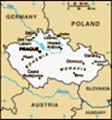Advertisement
Published: June 10th 2016
I went to sleep last night thinking about the prison cells at the Little Fortress / the local Gestapo headquarters in Terezín, Czech Republic.
https://www.ushmm.org/wlc/en/article.php?ModuleId=10005424 There are a variety of sizes and shapes, but mostly they are rectangular, about 15’ x 25’ with a high barrel ceiling. They are whitewashed and have a window set in one end. A sink and enclosed toilet are the sole sanitary facilities for the roughly 70 men who might have been housed there. The bunk beds were made of rough cut wood and must have slept about 5 a piece.
The isolation cell, reserved for ‘criminals’, was bleak and without any plumbing and very little ventilation. The only window was very small and set high in the wall. It too might hold as many as 70, But only if they all stood up the whole time.
There is nothing particularly foreboding about this place. It could just as easily be a spartan kind of barracks. Maybe with slightly improved plumbing and beds. It looked very much like some of the Revolutionary and Civil War forts I visited as a child.
The cruelty and depravity came not from the buildings, but from
the conditions and the behavior of the guards.
As with everything else the National Socialists did, there were records, detailed records that began the moment a prisoner arrived. The office where prisoners were booked in looked like any other office, desks, chairs, a telephone, ranks of shelves for storing records. A clerk here could be content that he was just keeping records, helping to facilitate the maintenance of law and order.
Terezín was, and is, a small walled town of about 3,000 people, 35 miles north of Prague. Its proximity to Prague and its walls made it an ideal location for a “model” camp, one that could be shown to the international community to prove false the rumors of maltreatment and mass murder of Jews and others deemed socially undesirable.
In 1942, the existing population was ordered to evacuate the town. Their homes and public buildings were confiscated and became the “homes” of many thousands of Jews. (In yet another example of the perversity of the SS bureaucratic mind, Terezín ‘residents’ were required to send official, SS-issued stamps to friends and relatives on the outside to be affixed to food and other packages to be sent to Terezín. Without the stamp, packages would be rejected or more likely stolen by the guards.) Schools and other public facilities were recreated to further the deception that this was a relocation site, not a way station on the path to something far worse.
Rejecting the premise that everything was ‘for show,’ the Jewish Council that was responsible for administration (within strict Nazi guidelines and with few resources) and the teachers and social workers who worked with families and children worked heroically to create ‘normal’ conditions. Wells were dug to increase the supply of useable water, physicians and other healthcare workers operated clinics, shopkeepers bought and sold things using the otherwise worthless script the Germans issued. Education was continued and art and music were encouraged and shared. It was hard for me to imagine the kind of ‘split consciousness’ that must have occurred among the teachers, trying to prepare young people for a hopeful future while knowing that most likely they were all going to die, soon.
One student poet František Bass, appears to have understood,
A little garden,
Fragrant and full of roses.
The path is narrow
And a little boy walks along it.
A little boy, a sweet boy,
Like that growing blossom.
When the blossom comes to bloom again,
The little boy will be no more.
I cannot imagine what it would be like to be a teacher and receive this from a bright young student. František Bass died when he was 14 years old.
The transports east to the labor and extermination camps started the year Theresienstadt, the Germanized name given to the town, was established as a camp. Some 155,000 people lived in Terezín at one time or another. Thirty-five thousand died there, 83,000 perished in the camps or on the “death marches” that followed the decision to close camps as the Soviet armies retook territory. Of the thousands of children sent east, 245 are known to have survived.
The international visitors, it seems ludicrous to call them inspectors, reported that all was well in Theresienstadt.
The intuition that was forming after our experiences in Munich, Nürnberg, and Berlin was reinforced in Terezín. A big part of the success of the SS and the National Socialists was their ability to ‘utilize the ordinary in the service of the unspeakable.’ At least in part, I think, this was the point Hannah Arendt was making in
Eichmann in Jerusalem, 1963, and the phrase “the banality of evil.”
It is a deeply sobering thought in the current political climate in the US.
Advertisement
Tot: 0.082s; Tpl: 0.009s; cc: 11; qc: 50; dbt: 0.0469s; 1; m:domysql w:travelblog (10.17.0.13); sld: 1;
; mem: 1.1mb







